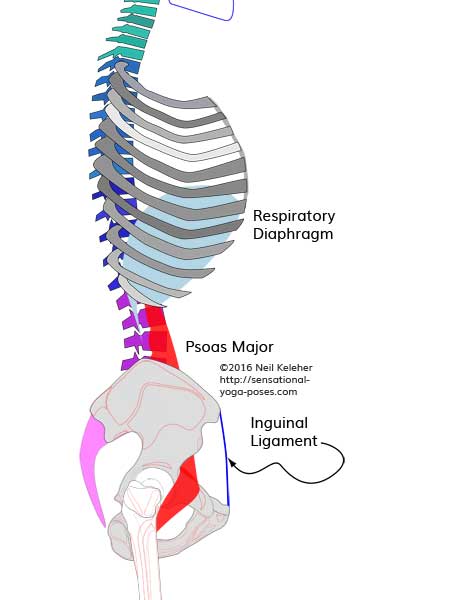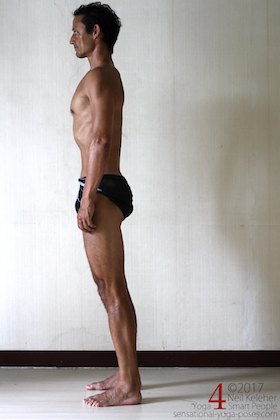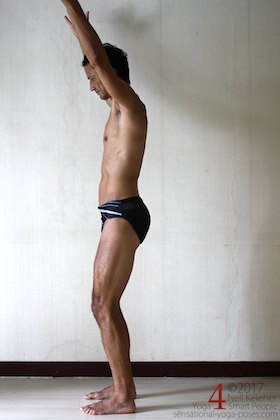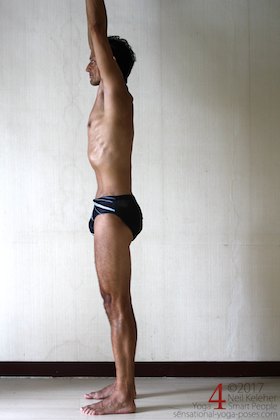Psoas Stretch
Standing Stretch for Psoas Upper and Lower Fibers
The psoas muscle attaches at one end to the lumbar vertebrae. After folding around the front of the pelvis the other end attaches to the inside of the femur, just below the neck, at the lesser trochanter. This point is towards the rear of the inner surface of the femur.
In terms of stretching the psoas muscle it can be useful to think of the psoas in two parts, the upper psoas muscle and the lower.
- The upper fibers are those that attach to the upper lumbar vertebrae and to the renal fascia.
- The lower fibers attach to the lower lumbar vertebrae.
You may find that to stretch the upper fibers, those that attach to the renal fascia, or if you like, to the backs of the kidneys, you can focus on lifting the 12th pair of ribs (to which the renal fascia have an attachment).
To stretch the lower portion, you may have to flatten the curve of the lumbar spine.
Both of these actions can be done while standing upright with knees straight.
Standing Psoas Stretch | Standing Psoas Stretch Variations
Some Psoas Anatomy: The Inguinal Ligament
To get to the thigh bone from the lumbar spine, the psoas actually passes beneath the inguinal ligament.
- This ligament forms the crease the separates each thigh from your belly.
- It attaches from the pubic bone to the ASIC (the point of the hip bone) on each side of the pelvis.
This ligament can be used as a reference flattening the lumbar spine to stretch the lower fibers of the psoas.
Flattening the Lumbar Spine
(To Stretch the Psoas)
Standing upright with feet parallel and knees slightly bent, :
- Focus on feeling your lower back, particularly your lumbar vertebrae.
- Also feel your inguinal ligaments.
Draw your lumbar vertebrae away from your inguinal ligaments so that the back of your lumbar spine flattens.
Your pelvis will more than likely tilt back as a result, that's fine, but rather than focusing on tilting your pelvis back, focus on flattening your lumbar spine so that your pelvis tilts back as a result of that.
Relax and repeat this action so that you get used to doing it without having to think about it.
Once you get a feel for the action, work at making both actions (flattening and then relaxing) slow and smooth.
The Lower Transverse Abdominis
You may notice that as you flatten your lumbar spine, you lower belly pulls in. This may be more likely to happen if you focus on pulling your lumbars away from your inguinal ligaments.
The lower transverse abdominis attaches to the inguinal ligament (as well as the ASICs) and your lower belly pulling it is a sign that they, the lower fibers of the Transverse Abdominus, are contracting.
Note that because the knees are slightly bent you may not be stretching your psoas yet (unless it is particularly tight).
Using Your PC Muscles
(To Help Stretch the Psoas Muscle)
An action that may help in stretching the lower fibers of your psoas is pulling your tailbone towards the pubic bone so that the pelvic floor muscles activate.
For guys the amount of movement of the sacrum relative to the pelvis will probably be very slight, none the less, the muscle tension created may be helpful in stabilizing the SI Joint.
That in turn may make it easier to stretch your psoas.
Note that drawing the tailbone towards the pubic bone is not the same as tilting the pelvis back. Instead this actions shortens the distance between tailbone and pubic bone by tilting the sacrum backwards relative to the pelvis. The amount of tilt will be slight, barely perceptible. But see if you can feel a change in tension when doing this action.
To practice it draw your tailbone towards you pubic bone, then relax. Then repeat.
Activating Your Pelvic Floor Muscles then Flattening Your Lumbar
To combine these actions
- First draw the tailbone towards your pubic bone. You may find that your pelvis automatically begins to tilt back.
- Next, pull your lumbars away from your inguinal ligaments (or if you like, away from your pubic bone.
- Relax and repeat this sequence of actions till you get a feel for it and can do it without having to think about how to do it.
Lifting Your Back Ribs to Stretch Your Psoas
All of these actions so far will probably affect the lower fibers of the psoas. To affect the upper fibers lift your back ribs. Here again, practice this in isolation.
- You may find it helps to hunch your back initially.
- Or focus on pulling upwards on the rear of your kidneys. (The kidneys are located at about the level of the 12th ribs.)
- You may find that your upper belly pulls in (or becomes hard) when you do this.
Now there are two possible sequences for putting all of these actions together, and I'd suggest playing with both to find the one that feels best, or easiest to implement.
- First lift the back ribs, then flatten your lumbar spine after first drawing the tailbone forwards.
- Or do the tailbone/lumbar activation first then lift the back ribs.
If you have difficulty with any of the actions, you may find it helps to lead with that action.
Fixing One End of the Psoas
To effectively Stretch It
Now so far we've only talked about affecting the upper point of attachment of the psoas.
To stretch the psoas we need to work on both ends, fixing one end (either the upper end or the lower end) while drawing the other end away from it.
By doing the above actions first (activating pelvic floor, flattening lumbar spine, lifting lower back ribs), you secure the upper end.
- You could then straighten the knees and push back on the inner thighs in such a way that the thigh bones press straight back to work on the lower end in such a way that the psoas gets stretched.
- Or straighten the knees and brace the thighs first, then activate the pelvic floor and flatten the lumbars
Note that one way that you could deepen the psoas stretch is to press your hips forwards. If doing this, work at keeping your lumbar spine flat (and your pelvic floor muscles activated). Also keep pressing rearwards through your inner thighs.
Reaching the Arms Upwards
In the lying psoas stretch the psoas stretch is accentuated by reaching the arm past the head. You can do the same in the standing psoas stretch, reach both arms upwards and while doing so focusing on lifting the ribs and in general lengthening your spine upwards.
I'd suggest that this action is separate from lifting the lower back ribs. The feeling (and the effect) is slightly different. Lifting the arm and reaching the ribs up tends to affect the sides of the ribs more than the back, especially if reaching with both arms at the same time.
To that end, if you start with your arms lifted, but relaxed, then after activating your pelvic floor, flattening your lumbar and lifting your lower back ribs, then reach the arms up and lift the side ribs at the same time.
With practice all of these little actions become automatic and you can do them without having to think about them, while still being able to notice whether or not you've done them.
Continue reading Psoas Stretch Variations.
Related
The Reclining Psoas Stretch
Active Psoas Stretches
More Hip Flexor Stretches
Counter Psoas Stretches with Glute Stretches
Published: 2020 08 03
Updated: 2021 01 29










